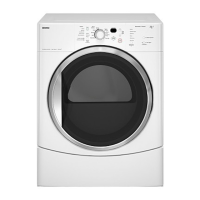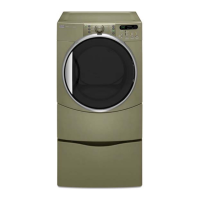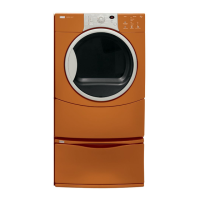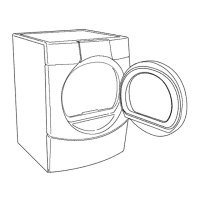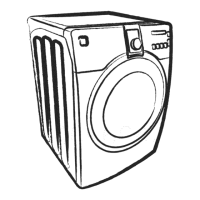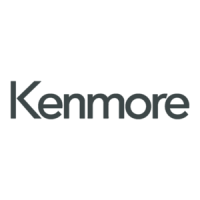
Do you have a question about the Kenmore HE2 110.8656* and is the answer not in the manual?
| Appliance Category | Dryer |
|---|---|
| Brand | Kenmore |
| Model Number | 110.8656* |
| Fuel Type | Electric |
| Capacity | 7.0 cu. ft. |
| Color | White |
| Voltage | 240 V |
| Amperage | 30 A |
| Width | 27 inches |
| Drum Material | Stainless Steel |
| Number of Temperature Settings | 5 |
| Wrinkle Guard Option | Yes |
| End of Cycle Signal | Yes |
| Energy Star Certified | No |
| Weight | 120 lbs |
| Drying Cycles | Normal, Delicates, Heavy Duty, Timed Dry |
Details the benefits and coverage of the Kenmore Master Protection Agreement for new products.
Provides contact information for professional installation services offered by Sears for home appliances.
Outlines the one-year full warranty for the HE2 dryer, including restrictions and service details.
Details the one-year warranty for the optional dryer pedestal, including restrictions and service.
Lists essential safety precautions for operating the dryer to prevent fire, shock, or injury.
Lists necessary tools and parts for installing the dryer.
Specifies environmental and spatial requirements for dryer installation.
Provides minimum spacing dimensions for various installation types like closet or undercounter.
Outlines special provisions and hardware for mobile home dryer installations.
Explains the different electrical supply connections (3-wire vs. 4-wire) and outlet types.
Provides essential guidance on proper grounding for electric dryers to prevent shock.
Details the process for 4-wire power supply cord and direct wire connections.
Details the process for 3-wire power supply cord and direct wire connections.
Step-by-step instructions for connecting the dryer using a 4-wire direct method.
Step-by-step instructions for connecting the dryer using a 3-wire direct method.
Details the options for connecting a 4-wire power supply cord or direct wire.
Details the options for connecting a 3-wire power supply cord or direct wire.
Specific steps for connecting neutral and ground wires for a 4-wire direct connection.
Instructions for connecting a 3-wire power supply cord to the dryer.
Instructions for directly wiring a 3-wire cable to the dryer.
Steps for connecting a direct wire using the optional 3-wire method.
Specifies approved vent materials (heavy metal) and prohibits plastic or foil vents.
Details requirements for vent elbows, clamps, and installation practices.
Shows recommended and acceptable exhaust hood styles for dryer venting.
Illustrates different venting paths like rear, side, bottom, and close-clearance options.
Lists available kits for managing vent runs in close-clearance installations.
Provides a chart to determine vent length and elbow requirements for optimal drying.
Instructions for installing and adjusting the dryer's leveling legs for stability.
Steps to change the dryer door's opening direction from right to left.
Detailed procedure for reversing the door hinge and strike plate.
Steps for reattaching the dryer door assembly after reversal.
Steps to verify installation, connect power, and prepare the dryer for operation.
Checks to perform if the dryer does not start or fails to heat.
Basic steps for powering on and starting the dryer, including safety warnings.
How to select and use automatic drying cycles based on load sensors.
Instructions for selecting and adjusting timed drying cycles and temperatures.
How to enable and disable the control lock feature to prevent accidental changes.
Tips for properly loading the dryer to ensure efficient drying and prevent damage.
Advice on selecting cycles, using temperature, and reducing wrinkles.
Explains the meaning of various status indicator lights on the control panel.
Description and settings for various automatic drying cycles.
Explanation of timed cycles and their preset settings for different load types.
How to select temperature settings for timed cycles using modifiers.
Details on using options like Wrinkle Guard and Cycle Signal to customize cycles.
Procedures for modifying cycles, options, or modifiers after the dryer has started.
Instructions for installing and using the non-heated dryer rack for delicate items.
Guide to suggested cycles, temperatures, and times for rack-dried items.
How to keep the area around the dryer clear for proper ventilation and safety.
Instructions for cleaning the lint screen before each load and periodic deep cleaning.
How to clean the dryer drum to remove residue and stains.
Procedures for removing lint from inside the cabinet and the exhaust vent.
Steps for preparing the dryer for periods of non-use or for moving.
Solutions for issues like the dryer not running or having no heat.
Troubleshooting steps for unsatisfactory drying, long times, or incorrect temperatures.
Addresses issues like lint on clothes, stains, wrinkles, and odors.
Troubleshooting steps for short cycle times, odors, and automatic cycle ending early.
